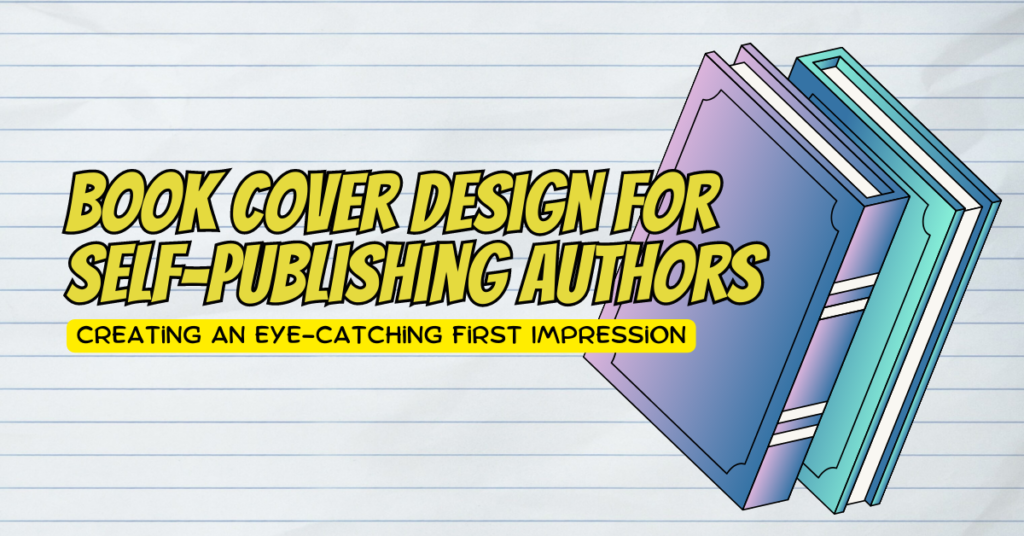In the competitive world of self-publishing, where countless books vie for readers’ attention, a professionally designed book cover is crucial for success. A well-designed cover is the first point of contact between a book and its potential readers, making a strong visual impression and enticing them to pick up the book. In this article, we will explore the importance of book cover design for self-publishing authors and provide insights into creating captivating covers that effectively represent the essence of their books.
Table of Contents
The Significance of Book Cover Design for Self-Publishing Authors

Grabbing Attention and Creating Interest
A book cover serves as the primary marketing tool for a self-published author. It can grab readers’ attention amidst a sea of competing books, compelling them to stop and take notice. A visually striking cover can create curiosity and generate interest, prompting readers to explore the book’s content further and potentially make a purchase.
Establishing Genre and Setting Expectations
A well-designed book cover effectively communicates the genre and sets appropriate expectations for the reader. Different genres have distinct visual cues and conventions, and a professionally designed cover ensures that the book aligns with readers’ expectations. A cover that accurately represents the genre helps attract the target audience and avoids misleading or disappointing potential readers.
Conveying the Book’s Essence and Theme
A book cover visually represents the book’s story, themes, or mood. It gives readers a glimpse into the world they will enter when they read the book. An effective cover design captures the essence of the story, whether through imagery, typography, color schemes, or symbolic elements. It creates an emotional connection and resonates with the book’s target audience.
Critical Elements of Book Cover Design
Striking Visuals and Imagery
Visually compelling and high-quality imagery is crucial in grabbing readers’ attention. Whether it’s an eye-catching photograph, an intricate illustration, or a well-crafted combination of graphical elements, the imagery should evoke the book’s genre and theme while creating a sense of intrigue. The choice of imagery should be thoughtful and align with the target readers’ preferences.
Typography and Font Selection
The typography used on a book cover is an important design element that sets the tone and enhances the overall visual impact. The font selection should be carefully considered to ensure readability, visual harmony, and relevance to the genre and theme of the book. The font size, style, and placement should be legible and easily recognizable, even in thumbnail sizes.
Color Palette and Mood
Colors evoke emotions and convey specific moods. The color palette chosen for a book cover should align with the book’s genre, themes, and intended atmosphere. Bright and vibrant colors may suit a lighthearted romance, while darker and subdued tones may be more fitting for a mystery or thriller. Consistency in color choices throughout the cover design creates visual cohesion and strengthens the overall impact.
Layout and Composition
An effective cover design incorporates a well-balanced layout and composition. The placement of imagery, title, author name, and other textual elements should be carefully arranged to create a harmonious and visually appealing design. The hierarchy of information is essential, ensuring that the title and author name are prominent and easily readable.
Working with a Professional Book Cover Designer
Finding a Reputable Book Cover Designer
Self-publishing authors may benefit from working with professional book cover designers with expertise in creating captivating covers. Researching and finding a reputable designer with a portfolio that aligns with the desired style and genre can significantly enhance the visual appeal and marketability of the book.
Collaborating with the Designer
Collaboration between the author and the designer is crucial to ensure the cover accurately represents the book’s essence. Authors should provide the designer with a clear vision and a brief that outlines the book’s genre, themes, and target audience. Regular communication and feedback throughout the design process allow authors to provide input and guide the design direction.
Utilizing Design Resources and Stock Imagery
Design resources, such as stock imagery libraries and design templates, can be valuable assets for self-publishing authors and their designers. These resources offer a wide range of high-quality visuals that can be customized to create unique and engaging book covers. Selecting resources that provide appropriate licensing and permissions for commercial use is essential.
Frequently Asked Questions (FAQs)
How much does a professional book cover design cost?
The cost of a professional book cover design varies depending on several factors, including the designer’s experience, the complexity of the invention, and additional services required (such as custom illustrations or photo shoots). Prices can range from a few hundred to several thousand dollars. Researching and obtaining quotes from multiple designers is advisable to balance budget and quality.
What information should authors provide to the book cover designer?
Authors should provide the book cover designer with essential information about the book, including the genre, target audience, key themes, and any specific imagery or concepts they envision. Sharing excerpts, summaries, or mood boards can help the designer better understand the book’s tone and atmosphere.
How can authors ensure that the book cover design aligns with their vision?
Clear communication, collaboration, and feedback with the book cover designer are vital to align the design with the author’s vision. Providing detailed feedback during the design process, pointing out elements that resonate or require adjustments, and sharing references or examples of covers that inspire the desired direction can help shape the final design to align with the author’s expectations.
What are the essential elements to include on a book cover?
The essential elements to include on a book cover are the title, author name, and relevant subtitle (if applicable). Including endorsements or review snippets, series information, and a brief book description is standard on the back cover. However, the elements may vary depending on the book’s genre, market, and design preferences.
Is it necessary to have a physical book cover design if the book is only available in e-book format?
A visually appealing cover is still crucial even if a book is only available in e-book format. The e-book cover serves as the thumbnail or digital representation of the book in online marketplaces, making it the first impression for potential readers. A professional e-book cover design contributes to discoverability, reader engagement, and overall sales.
Can authors update or change their book cover design after publication?
Authors can update or change their book cover design after publication, especially in self-publishing. If a cover design is not resonating with readers or the author’s vision has evolved, a revised cover can be uploaded and replaced across online platforms. However, it is essential to consider the potential impact on existing marketing efforts and the need to coordinate any changes with the book’s distribution channels.
Conclusion
For self-publishing authors, a professionally designed book cover is a powerful marketing tool that can significantly attract readers and boost book sales. By capturing attention, accurately representing the book’s genre and essence, and creating an emotional connection, a well-designed cover sets the stage for a compelling reading experience. Collaborating with a professional book cover designer and investing in quality design can significantly enhance a self-published book’s visibility, appeal, and success.






